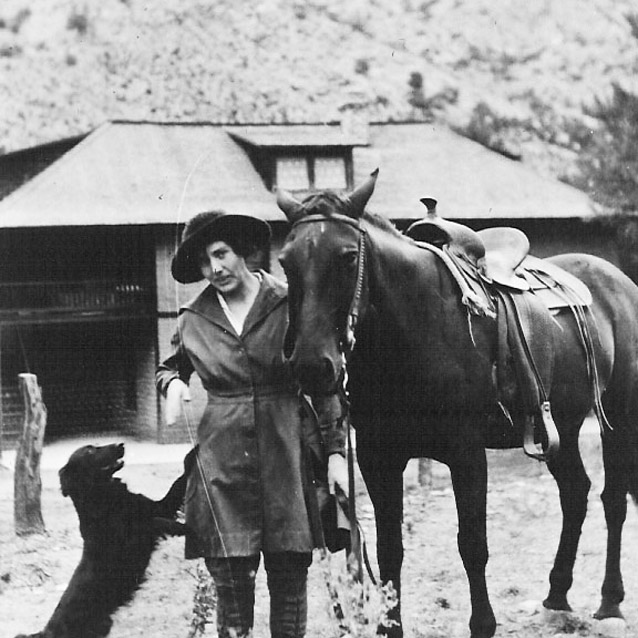When the CCC camp closed in 1940, all of the structures were left on the Riggses’ property. Ed and Lillian turned the structures into lodgings for large groups of tourists and called it “Camp Faraway.”
They leased the camp out to a businessman named William Sprague. World War II impacted the guest ranch business, and Camp Faraway initially struggled to turn a profit. Ed and Lillian were having troubles with Faraway Ranch as well. By the mid-1940s, Ed and Lillian started to consider leaving the business. Both were growing older, and Lillian, who had been steadily losing her hearing also lost her eyesight. By 1942 she was blind. In 1945 they sold Camp Faraway, the upper portions of the ranch, and a portion of the Stafford property to William Sprague and his partners. As part of the deal, the Riggses agreed to remain out of the guest ranch business for ten years, although they could still rent cottages to a few people on a limited basis.
Despite the agreement, Ed and Lillian remained very involved in the tourism industry. They still greeted visitors to the national monument and led horseback riding trips. Lillian admitted that they missed many aspects of operating a guest ranch, particularly the opportunity to meet new people, and the couple discussed buying back the portions of the ranch that they had sold. In 1950, however, Ed died of a cerebral hemorrhage, and a few months later, Lillian’s mother, Emma, died as well. Her father had passed away in 1937. Lillian was now alone at Faraway, faced with the prospect of managing the ranch by herself.

NPS
Lillian sank into a depression and considered moving away from Faraway. Ultimately, she decided to reopen the ranch as a guest lodge in 1955, when the ten year agreement with Sprague expired. After suffering a recession during the war, the tourism industry had exploded in the 1950s. More Americans than ever before were taking vacations, and the West remained a popular destination. The old model of dude ranches had fallen out of favor—most guest lodges no longer offered the opportunities for tourists to actually participate in ranch work and many were no longer working ranches. They became resorts, housing large numbers of guests, and offering activities that recreated a mythical approximation of Western life. Lillian did not try to resurrect Faraway as it had been back in the twenties and thirties; she simply provided lodging and meals for guests. Still, although the numbers of cows steadily diminished, Lillian continued to keep a cattle herd.
Lillian often struggled with the demands of the business, and in the 1960s she leased out the guest ranch to other entrepreneurs. None of the leases lasted long, and Lillian began thinking of selling the ranch, perhaps to a national chain like the Holiday Inn. She soon realized, however, that Faraway’s long relationship with the Chiricahua National Monument precluded this possibility. In 1938 the monument had been expanded by 8,000 acres, and Faraway Ranch became an inholding, surrounded on all sides by monument land. By the 1960s, the National Park Service was seeking to acquire all remaining inholdings. In 1970, at the age of eighty-two, Lillian closed the guest ranch. She continued to keep over seventy head of cattle. As her health declined, Lillian expressed her wish to die at home and be buried in her wedding dress. Ultimately, she had to move to a nursing facility in the Willcox hospital at a nearby town, where she died in 1977. The National Park Service acquired the Faraway Ranch in 1979, thus preserving a landscape that had been a de facto part of the monument for decades.
Part of a series of articles titled The Story of Faraway Ranch.
Last updated: March 18, 2016
